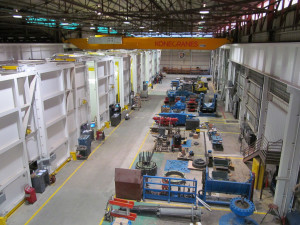BOP facility designed with manufacturing principles for maximum efficiency, minimum lost time

By Katherine Scott, associate editor
As industry drills deeper wells in increasingly harsh environments, the upper limits of BOP equipment is constantly being pushed. Even under such conditions, a BOP and its sealing elements must perform flawlessly. Such high performance can be achieved only through aggressive development and testing, said Joe Liotta, National Oilwell Varco (NOV), at the 2013 SPE/IADC Drilling Conference & Exhibition this week in Amsterdam. Testing and qualification of BOP equipment as detailed by API Spec 16A requires facilities with the capability to test BOPs in multiple environments and operating scenarios. NOV’s R&D center, located in Houston, is equipped for testing fatigue, high temperatures up to 177°C (350°F), low temperatures down to -26°C (-15°F), stripping, hang off, sealing characteristics and shearing.
“We took a rather unique approach to the design of the facility,” he said, which has been operational since October 2011. “We looked at manufacturing principles, such as lean manufacturing and quick response manufacturing,” Mr Liotta said. Although such manufacturing methods are not usually applied to R&D testing facilities, “we felt that this would help to manage it such that we would maximize efficiency and minimize waste and lost time.”
The multimillion-dollar R&D lab, operated by NOV’s Pressure Control Group, is made up of two primary parts: eight large-bore test bays and five small-bore test bays. “You have dedicated people that work (in each cell) on specific equipment. It really helps to establish ownership in the products and the tests that are being performed,” Mr Liotta said in presenting SPE/IADC 163573 at the Drilling Conference. In most cases, NOV believes it’s important for the tests to exceed API’s minimum standard. “You’re not only testing the BOP but the supporting equipment at the same time.”
To determine whether a test is conducted, facility technicians go by three criteria: is the equipment prepared and available, the priority or importance of the test as determined by dedicated planners, and lab capacity, he said. In the past, it was common to run tests in a sequential process: prepare and complete one test and then look for what was next. “But with all this infrastructure (in the lab), we knew in order to keep it busy, we needed to set up a parallel process. So now we have dedicated teams that prepare all the kit required to perform a test and stage it all together while the tests are being performed. That way, as soon as a bay becomes available, the test is completed, and the next test can be started from there.”
High- and low-temperature tests are among five other types of BOP tests that can be run at the lab. Per API Spec 16A Section 5, there are six dedicated low-temperature ratings and six high-temperature ones, ranging between -26°C (-15°F) and 177°C (350°F). Testing and qualifications also must account for valves, hoses, fluids and any other components of the equipment that might be exposed to these extreme temperatures. A room built for the low-temperature tests is fully insulated, including the floor to prevent groundwater from freezing. The company also developed a system of cooling the BOP from the inside to decrease the time needed for each test.
Another test that gets a lot of attention is the fatigue test, Mr Liotta said. “It’s important because of reliability, and it’s also very hard on the infrastructure and on the processes because it takes so long to run. We found we could complete a full fatigue test in about 36 to 48 hours, and that’s great because then we can repeat the test, and we can try other variables or other test conditions, which results in a more robust product.” Among the challenges of conducting a fatigue test are having a system that has minimal technician involvement, logging sufficient data for the test and maintaining complete control over operator pressure from external source.
A sealing characteristics test, according to API 16A, “determines the actual opening or closing pressure required to either maintain or break a wellbore pressure seal. The test shall also define the ability of the ram packer to affect a seal when closing against elevated wellbore pressure.” Documentation includes a record of closing pressure versus wellbore pressure to affect a seal against elevated wellbore pressure, and a record of operator (closing or opening) pressure versus wellbore pressure to break a wellbore pressure seal. Mr Liotta said the biggest challenge in this test is the second part, ram closure against elevated wellbore pressure.
Because schedules can change several times a day in the R&D lab, NOV has developed a “dashboard” work order system so employees can see what’s going on in each test bay. The dashboard also serves as a portal for data collection, and historical data can be leveraged to generate performance metrics and downtime information. This data can expose areas of improvements and drive process improvement projects. Further, “each of the stations has a control panel located outside the bay, and they have full control and can see 360° cameras,” Mr Liotta said. “The goal is eventually to automate the testing with the controls that we have in place, so that we could maybe have one technician perform testing that’s automated in two bays.”




